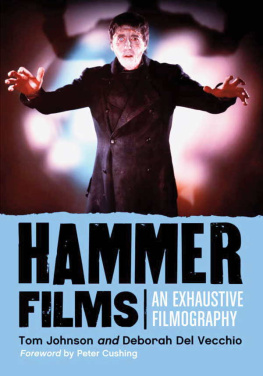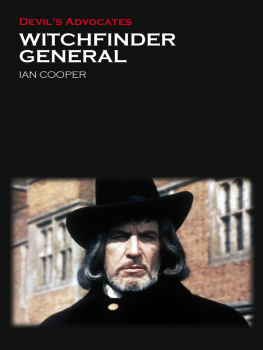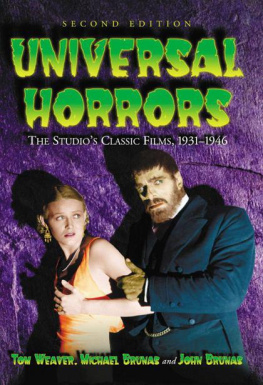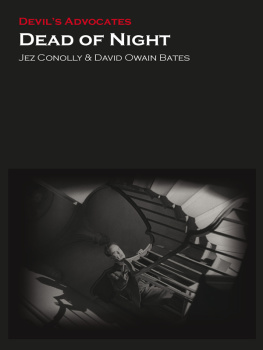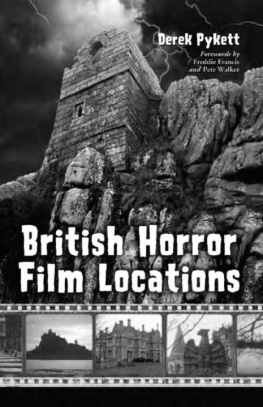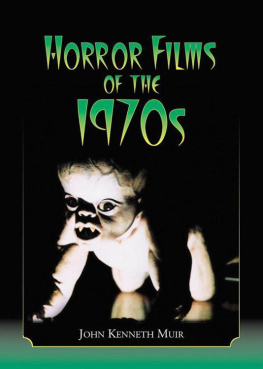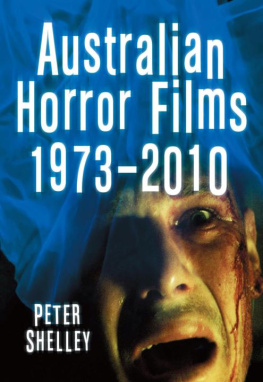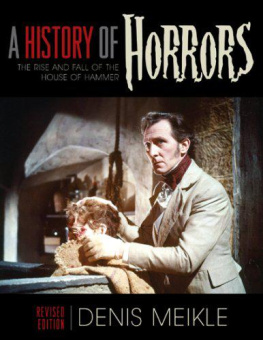
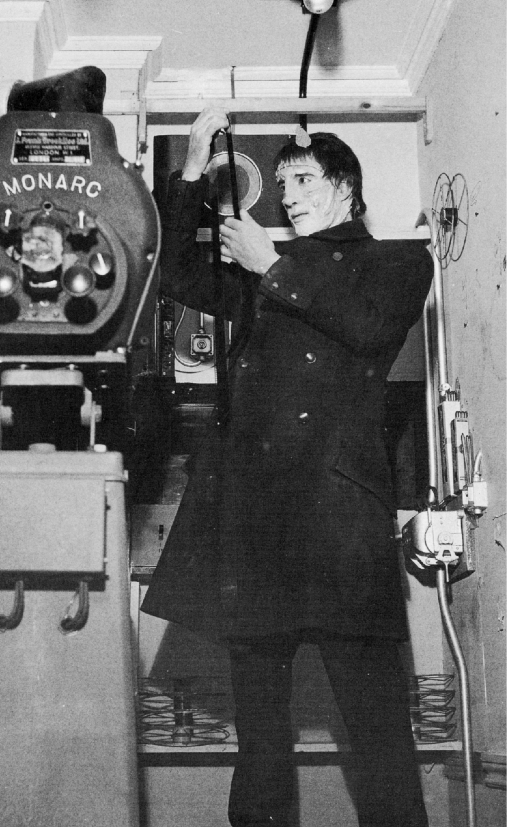
Christopher Lee checks the dailies during the production ofThe Curse of Frankenstein(1956).
HAMMER FILMS
AN EXHAUSTIVE FILMOGRAPHY
TOM JOHNSON and
DEBORAH DEL VECCHIO
with a Foreword by PETER CUSHING, OBE
an Introduction by JIMMY SANGSTER
and an Afterword by JAMES BERNARD

McFarland & Company, Inc., Publishers
Jefferson, North Carolina, and London
Also of interest are the following works from McFarland:
Peter Cushing: The Gentle Man of Horror and His 91 Films, by Deborah Del Vecchio and Tom Johnson (1992; paperback 2009); Censored Screams: The British Ban on Hollywood Horror in the Thirties (1997; paperback 2006) by Tom Johnson; Beverly Garland: Her Life and Career (2012) by Deborah Del Vecchio; The Christopher Lee Filmography: All Theatrical Releases, 19482003 (2004; paperback 2009) by Tom Johnson; The Mummy in Fact, Fiction and Film (2002; paperback 2007) by Susan D. Cowie and Tom Johnson; The Films of Oliver Reed (2011) by Susan D. Cowie and Tom Johnson
LIBRARY OF CONGRESS CATALOGUING DATA ARE AVAILABLE
BRITISH LIBRARY CATALOGUING DATA ARE AVAILABLE
e-ISBN: 978-0-7864-9186-5
1996 Tom Johnson and Deborah Del Vecchio. All rights reserved
No part of this book may be reproduced or transmitted in any form or by any means, electronic or mechanical, including photocopying or recording, or by any information storage and retrieval system, without permission in writing from the publisher.
Front cover image: Christopher Lee in The Curse of Frankenstein, 1957, directed by Terence Fisher, photographer John Jay (Photofest); cover design by David K. Landis (Shake It Loose Graphics)
McFarland & Company, Inc., Publishers
Box 611, Jefferson, North Carolina 28640
www.mcfarlandpub.com
For Len Harris, who saw most of it and remembered it all; the Cowies, who opened many doors (including their own); and Peter Cushing, OBE
TJ
For my beloved husband Carl, for my two mothersEdna and Antoinette, my father Raymond, and James Bernard
DDV
In Memory of Jon Weaver (19631995)
PREFACE
Although we, like most fans, were first attracted to Hammer for its Gothic horror movies, our purpose is to present an exhaustive reference work detailing all of their output that will reveal the company as a diversified producer of entertainment, rather than as the House of Horror. While it was certainly pictures like The Curse of Frankenstein and Dracula that brought Hammer its fame, the company worked in a variety of genres. Saddled with cramped conditions and even tighter budgets, Hammer managed to film war, mystery, science fiction, adventure, comedy, and even musicals in addition to the horrors.
Since Hammer is a British company, the focus of this book is British. The films are referred to by their original British titles and the emphasis is on their release and criticism within the United Kingdom.
We are well aware that not every Hammer film is a masterpiece, and that even many of the companys best pictures are flawed. While we often offer praise, we have tried to criticize each movie at its intended level; we do know the difference between Ben-Hur and The Brides of Dracula. Conversely, if we are a bit rough on a particular film, it is because of the high standard to which we hold the company.
A book like this requires the help of many people, and we were fortunate in the number of both celebrities and friends who came to our aid. If any big names are missing, please be assured that it was their decision not to become involved, rather than our lack of interest in securing their assistance.
Our special thanks to the late Peter Cushing, and to Jimmy Sangster and James Bernard, who were kind enough to contribute a Foreword, an Introduction, and an Afterword. A book about Hammer could have no better beginning or end. Others in the business who generously gave us their time were Barry Andrews, Samuel Z. Arkoff, Geoffrey Bayldon, George Baxt, Martine Beswicke, Norman Bird, Peter Blythe, Veronica Carlson, Herman Cohen, Hazel Court, Jim Danforth, Robert Day, Richard Gordon, Guy Green, Val Guest, Ken Hughes, Freddie Jones, the late Phil Leakey, Richard Matheson, Kerwin Mathews, Francis Matthews, Ingrid Pitt, Dave Prowse, Michael Ripper, Margaret Robinson, the late Cesar Romero, Don Taylor, and Geoffrey Toone. Without the valuable input of the late Len Harris, we would have been at a loss. Thank you one and all.
We also could not have done without Ann Del Vecchio, Carl Del Vecchio, Linda Greth, Elaine Hahn, Tammy Hahn, Debbie Hart, Fred Humphries, Doug Kauffman, Dick Klemensen (and Little Shoppe of Horrors), Gloria Lillibridge, Jessie Lilley, Greg Mank, Mark Miller, Mike Murphy, Tim Murphy, Joey OBrien, Ted Okuda, Louis Paul, Ernie Price, Ume Sommerlad, Gary and Sue Svehla (and Fanex), Tony Timpone (and Fangoria), Richard Valley, Randy Vest, Carol and Steve Werner, and Brent and Rebecca Worley. Tom Weaver helped rescue this book from overwriting, and Colin and Sue Cowie did far too much to even begin to thank them adequately.Without the cooperation of Roy Skeggs and Richelle Wilder of Hammer Films, this book could never have been written; and without the British Film Institute and Lincoln Center, we would have had very little to write about. Our sincere thanks to everyone for their kindness.
Tom Johnson
Deborah Del Vecchio
Summer 1995
FOREWORD
by Peter Cushing, OBE
When Tom Johnson and Debbie Del Vecchio told me they were writing a book about Hammer Films I was delighted, and even more so when they asked me if I would contribute a foreword.
It is a lovely feeling for an actor to be associated with success, especially when that success has givenand still givessuch pleasure all over the world. The story of the strides that Hammer made in one of the most competitive markets is remarkable, and perhaps it will inspire others to follow their example.
The narrative incorporates the films I was lucky enough to make with my very dear friend and colleague Christopher Lee, and I thought the following excerpt from my first book of autobiography might provide a fitting ending to this short beginning of what I am sure will be a volume much sought after by all lovers of the cinema:
Under Johns (John Redway & Associates) banner, I started my long and happy association with Hammer Film Productions. During this period of the film industrys turbulent history, a certain animosity existed towards anyone connected with television, because cinema attendance was dwindling, as audiences found that they could get all the entertainment they wanted in their own homes, just by the flick of a switch.But one company had other ideas. James (later Sir James) Carreras was the driving force behind that venturesome organisation, and reasoned sagaciously that if someone well-known and popular on the rival medium was starred in a film, that name could lure people back to those empty seats. He had been in constant touch with John, inviting me to work for them, but my commitments elsewhere prevented my accepting until 1957.
Way back in the thirties, after the tremendous stage success of
Next page
